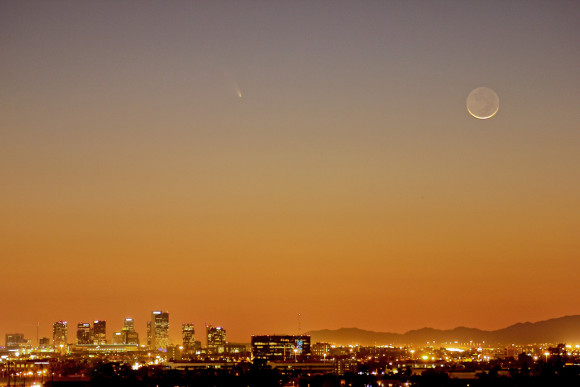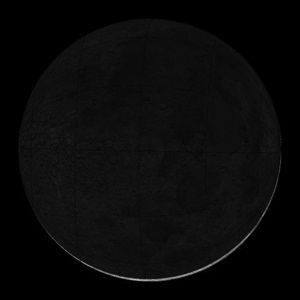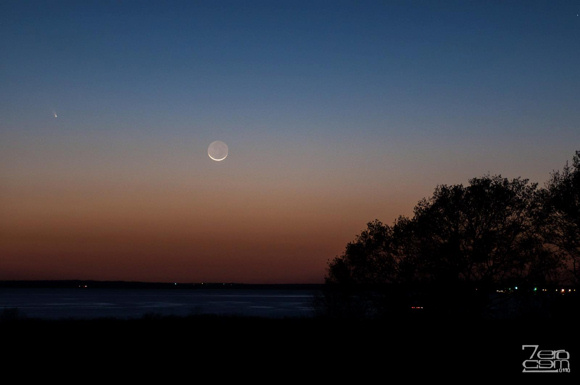 If your sky is clear, you should be able to see the waxing crescent moon smiling at you in the western evening dusk on March 13, 2013. The Northern Hemisphere is favored for this view (because the moon is lower in the sky after sunset and sets sooner after the sun, as seen from the Southern Hemisphere). Plus you might be able to catch Comet Panstarrs near the moon, especially if you use binoculars to search for it, as people around the globe did last night. On March 13, the comet will be located between the moon and the sunset point on the horizon. Is it visible to the eye? Well, maybe.
If your sky is clear, you should be able to see the waxing crescent moon smiling at you in the western evening dusk on March 13, 2013. The Northern Hemisphere is favored for this view (because the moon is lower in the sky after sunset and sets sooner after the sun, as seen from the Southern Hemisphere). Plus you might be able to catch Comet Panstarrs near the moon, especially if you use binoculars to search for it, as people around the globe did last night. On March 13, the comet will be located between the moon and the sunset point on the horizon. Is it visible to the eye? Well, maybe. Photo of Comet PANSTARRS and crescent moon from Belper, Derbyshire, England on March 13 at 7:15 p.m. This photo is from Jim Bell. Thanks, Jim! Pentax K5 – 70 – 300 zoom @300mm. Notice that the comet on March 13 is directly below the lighted portion of the crescent moon.,
Photo of Comet PANSTARRS and crescent moon from Belper, Derbyshire, England on March 13 at 7:15 p.m. This photo is from Jim Bell. Thanks, Jim! Pentax K5 – 70 – 300 zoom @300mm. Notice that the comet on March 13 is directly below the lighted portion of the crescent moon.,
Comet PANSTARRS on March 12, 2013 near the young moon. Photo by Russ Vallelunga in Phoenix, Arizona on March 12, 2013.
March is a great time to see the young moon because the ecliptic – plane of the solar system – is nearly perpendicular to the horizon on March evenings, as seen from Earth’s Northern Hemisphere. Meanwhile, from the Southern Hemisphere tonight, this young moon – and the comet – won’t be as easy to see, due to the shallow angle of ecliptic as seen from the southern half of Earth on March evenings.
, Young moon, like the one you'll see tonight if you look in the west shortly after sunset. It's a waxing crescent moon, due to show us more of its day side each evening.To see tonight’s young moon or the Comet Panstars (C/2011 L4) you need to find a level and unobstructed western horizon. If you don’t know which way west is, just remember it’s the sunset direction. Be don’t wait around. At northerly latitudes, the moon sets shortly after dark, and Comet Panstarrs sets even earlier – at late dusk or early evening.
Young moon, like the one you'll see tonight if you look in the west shortly after sunset. It's a waxing crescent moon, due to show us more of its day side each evening.To see tonight’s young moon or the Comet Panstars (C/2011 L4) you need to find a level and unobstructed western horizon. If you don’t know which way west is, just remember it’s the sunset direction. Be don’t wait around. At northerly latitudes, the moon sets shortly after dark, and Comet Panstarrs sets even earlier – at late dusk or early evening. Earthsky facebook Sergio Garcia Rill took this photo on March 12, 2013, from Lake Somerville State Park, near Somerville, Texas. Thank Meanwhile, folks at middle latitudes in the Southern Hemisphere – for example, South America, South Africa, Australia and New Zealand – won’t see the moon quite as easily after sunset this Wednesday evening. So why is the young moon more visible in the Northern Hemisphere? It’s because we are close to the spring equinox in the Northern Hemisphere, and it’s close to the autumn equinox in the Southern Hemisphere. On late winter/early spring evenings, the ecliptic – the pathway of the sun, moon, and planets – hits the horizon at the steepest angle for the year. But on late summer/early autumn evenings, the ecliptic hits the horizon at its shallowest angle.
Earthsky facebook Sergio Garcia Rill took this photo on March 12, 2013, from Lake Somerville State Park, near Somerville, Texas. Thank Meanwhile, folks at middle latitudes in the Southern Hemisphere – for example, South America, South Africa, Australia and New Zealand – won’t see the moon quite as easily after sunset this Wednesday evening. So why is the young moon more visible in the Northern Hemisphere? It’s because we are close to the spring equinox in the Northern Hemisphere, and it’s close to the autumn equinox in the Southern Hemisphere. On late winter/early spring evenings, the ecliptic – the pathway of the sun, moon, and planets – hits the horizon at the steepest angle for the year. But on late summer/early autumn evenings, the ecliptic hits the horizon at its shallowest angle.
From southern temperate latitudes, both the moon and the Comet Panstarrs are deeply buried in the glare of evening twilight
 Another fine photo of the young moon and Comet PANSTARRS (look left of the moon, right next to the cloud) by EarthSky facebook friend Kosen Ishikawa. Taken on March 12, 2013, from Poipu Beach Park, Kauai. Than you Kosen!,Bottom line: If blessed with an unobstructed western horizon and clear sky on March 13, 2013, you should catch the waxing crescent moon – and Comet PANSTARRS – in the west after sunset.
Another fine photo of the young moon and Comet PANSTARRS (look left of the moon, right next to the cloud) by EarthSky facebook friend Kosen Ishikawa. Taken on March 12, 2013, from Poipu Beach Park, Kauai. Than you Kosen!,Bottom line: If blessed with an unobstructed western horizon and clear sky on March 13, 2013, you should catch the waxing crescent moon – and Comet PANSTARRS – in the west after sunset.
No comments:
Post a Comment